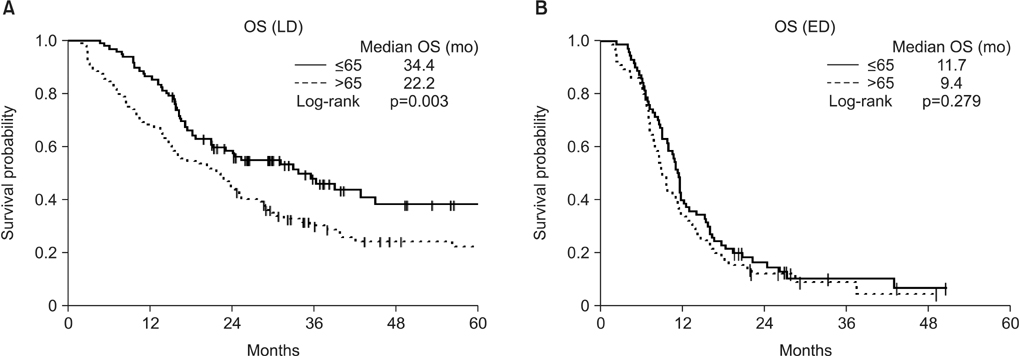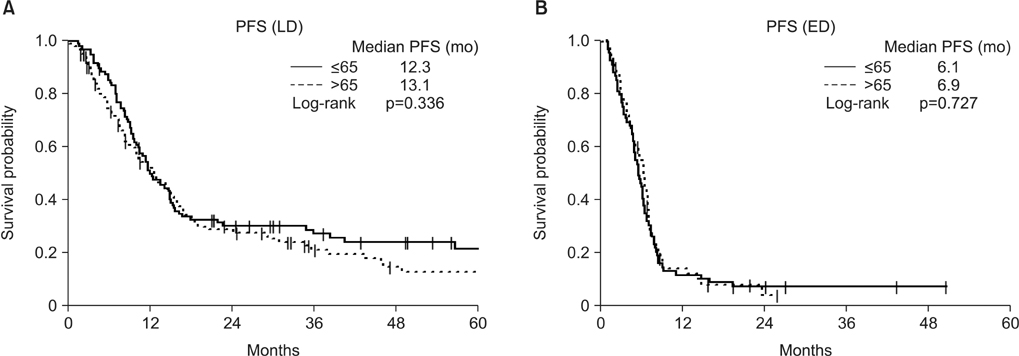Tuberc Respir Dis.
2016 Oct;79(4):274-281. 10.4046/trd.2016.79.4.274.
The Younger Patients Have More Better Prognosis in Limited Disease Small Cell Lung Cancer
- Affiliations
-
- 1Department of Internal Medicine, Asan Medical Center, University of Ulsan College of Medicine, Seoul, Korea.
- 2Department of Pulmonary and Critical Care Medicine, Asan Medical Center, University of Ulsan College of Medicine, Seoul, Korea. ccm@amc.seoul.kr
- 3Department of Oncology, Asan Medical Center, University of Ulsan College of Medicine, Seoul, Korea.
- 4Department of Biostatistical and Clinical Epidemiology, Asan Medical Center, University of Ulsan College of Medicine, Seoul, Korea.
- KMID: 2365319
- DOI: http://doi.org/10.4046/trd.2016.79.4.274
Abstract
- BACKGROUND
Factors associated with the prognosis of patients with small cell lung cancer (SCLC) is relatively unknown, than of those with non-small cell lung cancer. This study was undertaken to identify the prognostic factors of SCLC.
METHODS
The medical records of 333 patients diagnosed with SCLC at tertiary hospital from January 1, 2008, to December 31, 2012 were retrospectively reviewed. Patients were categorized by age (≤65 years vs. >65 years) and by extent of disease (limited disease [LD] vs extensive disease [ED]). Overall survival and progression free survival rates were determined. Factors associated with prognosis were calculated using Cox's proportional hazard regression model.
RESULTS
Most baseline characteristics were similar in the LD and ED groups. Eastern Cooperative Oncology Group (ECOG) performance status (PS), first chemotherapy regimen, and prophylactic cranial irradiation (PCI) differed significantly in patients with LD and ED. Mean ECOG PS was significantly lower (p<0.001), first-line chemotherapy with etoposide-cisplatin was more frequent than with etoposide-carboplatin (p<0.001), and PCI was performed more frequently (p=0.019) in LD-SCLC than in ED-SCLC. Prognosis in the LD group was better in younger (≤65 years) than in older (>65 years) patients, but prognosis in the ED group was unrelated to age.
CONCLUSION
This study showed that overall survival (OS) was significantly improved in younger than in older patients with LD-SCLC. Univariate and multivariate analyses showed that age, PCI and the sum of cycles were significant predictors of OS in patients with LD-SCLC. However, prognosis in the ED group was unrelated to age.
Keyword
MeSH Terms
Figure
Cited by 1 articles
-
Clinical Characteristics and Prognostic Factors of Lung Cancer in Korea: A Pilot Study of Data from the Korean Nationwide Lung Cancer Registry
Ho Cheol Kim, Chi Young Jung, Deog Gon Cho, Jae Hyun Jeon, Jeong Eun Lee, Jin Seok Ahn, Seung Joon Kim, Yeongdae Kim, Young-Chul Kim, Jung-Eun Kim, Boram Lee, Young-Joo Won, Chang-Min Choi
Tuberc Respir Dis. 2019;82(2):118-125. doi: 10.4046/trd.2017.0128.
Reference
-
1. Martini B. Lung cancer: epidemiology, prognosis and therapy. Med Monatsschr Pharm. 2006; 29:217–221.2. Aarts MJ, Aerts JG, van den Borne BE, Biesma B, Lemmens VE, Kloover JS. Comorbidity in patients with small-cell lung cancer: trends and prognostic impact. Clin Lung Cancer. 2015; 16:282–291.3. Shin SY, Lyu Y, Shin Y, Choi HJ, Park J, Kim WS, et al. Lessons learned from development of de-identification system forbiomedical research in a Korean tertiary hospital. Healthc Inform Res. 2013; 19:102–109.4. Shin SY, Park YR, Shin Y, Choi HJ, Park J, Lyu Y, et al. A Deidentification method for bilingual clinical texts of various note types. J Korean Med Sci. 2015; 30:7–15.5. Siu LL, Shepherd FA, Murray N, Feld R, Pater J, Zee B. Influence of age on the treatment of limited-stage small-cell lung cancer. J Clin Oncol. 1996; 14:821–828.6. Gridelli C, Casaluce F, Sgambato A, Monaco F, Guida C. Treatment of limited-stage small cell lung cancer in the elderly, chemotherapy vs. sequential chemoradiotherapy vs. concurrent chemoradiotherapy: that's the question. Transl Lung Cancer Res. 2016; 5:150–154.7. Rossi A, Maione P, Colantuoni G, Guerriero C, Ferrara C, Del Gaizo F, et al. Treatment of small cell lung cancer in the elderly. Oncologist. 2005; 10:399–411.8. Ludbrook JJ, Truong PT, MacNeil MV, Lesperance M, Webber A, Joe H, et al. Do age and comorbidity impact treatment allocation and outcomes in limited stage small-cell lung cancer? a community-based population analysis. Int J Radiat Oncol Biol Phys. 2003; 55:1321–1330.9. Chen J, Jiang R, Garces YI, Jatoi A, Stoddard SM, Sun Z, et al. Prognostic factors for limited-stage small cell lung cancer: a study of 284 patients. Lung Cancer. 2010; 67:221–226.10. Radzikowska E, Roszkowski K, Glaz P. Lung cancer in patients under 50 years old. Lung Cancer. 2001; 33:203–211.11. Shepherd FA, Amdemichael E, Evans WK, Chalvardjian P, Hogg-Johnson S, Coates R, et al. Treatment of small cell lung cancer in the elderly. J Am Geriatr Soc. 1994; 42:64–70.
- Full Text Links
- Actions
-
Cited
- CITED
-
- Close
- Share
- Similar articles
-
- Comprison of p53 Mutation in Non Small Cell Lung Cancer between Young patients and Old Patients
- Chemotherapy for Small Cell Lung Cancer
- Druggable Targets of Squamous Cell Lung Cancer
- Successful Treatment of Small-Cell Lung Cancer With Irinotecan in a Hemodialysis Patient With End-Stage Renal Disease
- A Clinical Therapeutic Results on Small Cell Lung Cancer



